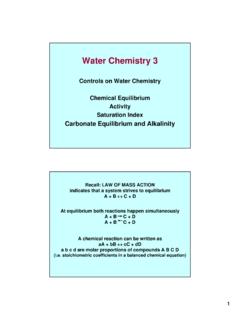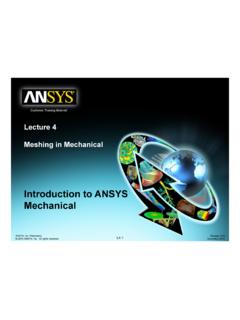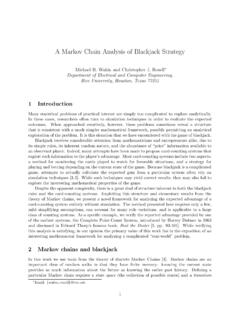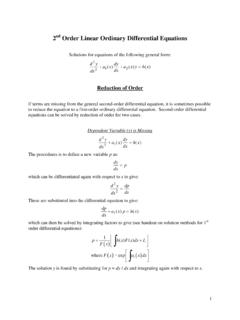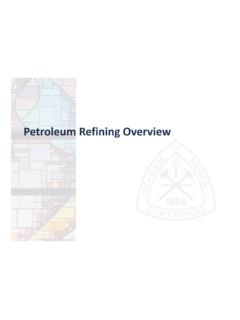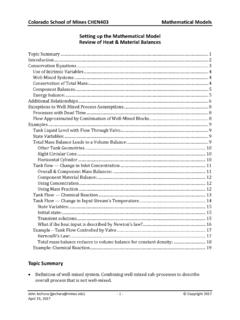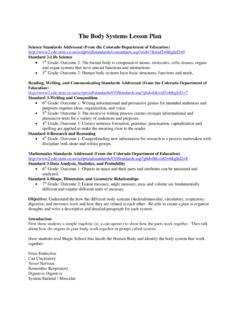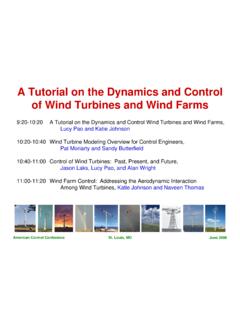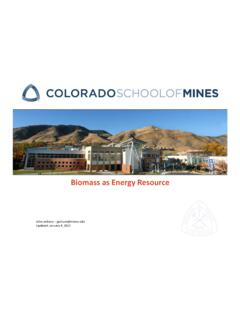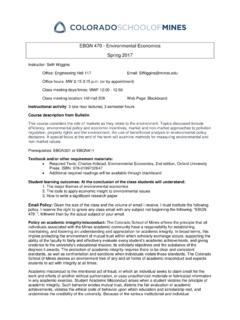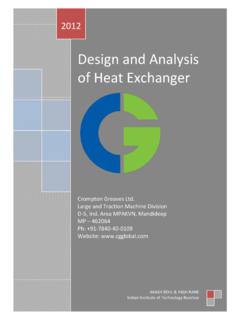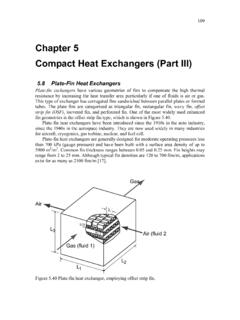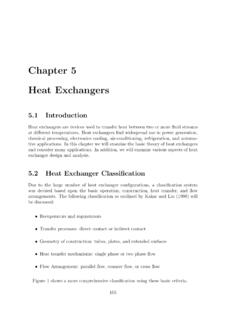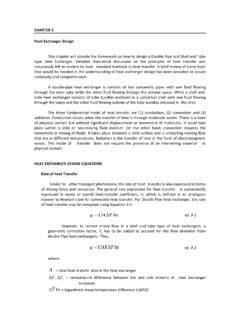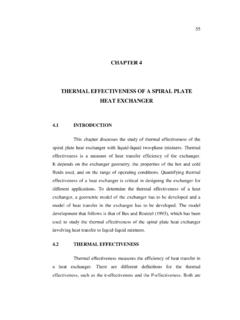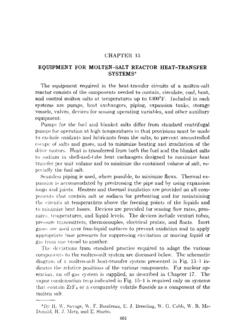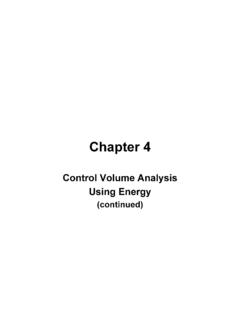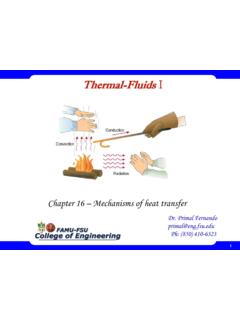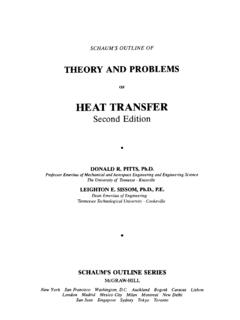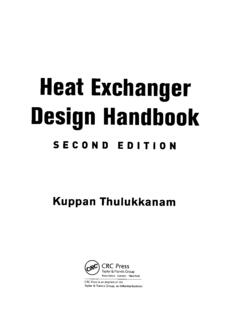Transcription of Equipment Fundamentals: Heat Exchangers - Inside Mines
1 Equipment Fundamentals: heat ExchangersChapter 3 Updated: January 29, 2019 Copyright 2019 John Jechura heat Exchangers Combines information about fluid flow & heat transfer across internal boundaries Considerations When do I need to know the specifics of the heat exchange configuration? How is the heat transfer coefficient related to the outlet temperatures? What is an approach temperature?Fundamentals of heat transfer & exchange heat transfer across boundaries Conduction Convection Radiation Coupled with internal energy changes Sensible heat effects Phase change2 Updated.
2 January 29, 2019 Copyright 2019 John Jechura of heat transfer & exchange heat transfer across boundaries Conduction Convection Radiation Coupled with internal energy changes Sensible heat effects Phase change Area-averaged temperature differenceEquipment heat Exchangers Combines information about fluid flow & heat transfer across internal boundaries Considerations When do I need to know the specifics of the heat exchange configuration? How is the heat transfer coefficient related to the outlet temperatures? What is an approach temperature?3 Updated: January 29, 2019 Copyright 2017 John Jechura January 29, 2019 Copyright 2019 John Jechura Transfer Modes of heat transferConduction Flow of heat through material with no bulk movement of the material itself Usually thought of through solid, but can also be through a stagnant fluid For a flat sold: Through a circular pipe: Through a sphere:5 = hotcoldTTQkAx()() = 2lnhotcoldoiQk TTLD D() = +211hotcoldioQk TTDDU pdated.
3 January 29, 2019 Copyright 2019 John Jechura Transfer Modes of heat transferConvection Flow of heat associated with fluid movement natural & forced convectionRadiation heat transferred via electromagnetic radiation6()= hotcoldQh TTA()()()()= = ++ 4422hotcoldhotcoldhotcoldhotcoldQTTATTTT TTU pdated: January 29, 2019 Copyright 2019 John Jechura Exchangers Some BasicsFocus is on the systemto have heat flow from the hot fluid(s) to the cold fluid(s) usually without direct contact Use bulk flow parameters to relate the heat conduction across the flow barrier to the change in energy of the hot & cold fluids Account for the series of resistances to heat transfer between the hot & cold fluidsHeat Exchangers heat to & from flowing fluids through impermeable barrier(s)
4 Driving force for heat through barriers is the temperature difference between the two fluids on opposite sides of the barrier Relate the heat effects in the flowingfluids to the change in enthalpy Often this can be related to the difference in the inlet & outlet temperatures for the fluids 7()()()()= = = = ,,,,,,,,,,,, for constant for constant HHH inH outHHp HH inH outp HCCC outC inCCp CC outC inp CQm HHQm CTTCQm HHQm CTTCU pdated: January 29, 2019 Copyright 2019 John Jechura Exchangers Some Basics Relate the heatacross the barrier to the temperature difference across the barrier It can be shown that for many typical configurations the AREA AVERAGED temperature difference is the LMTD (Log Mean Temperature Difference)8()()()()() = ,0,0,1,1,0,0,1,1 where lnHCHCLMLMHCHCTTTTQUATTTTTTxTH,inTH,outT C,inTC,outTH(x)TC(x)()()() = = AREA AVERAGED/hchcd Q LU TTQUA TTdxUpdated.
5 January 29, 2019 Copyright 2019 John Jechura Exchangers Some BasicsLMTD is a prescribed calculation calculating the LMTD from the procedure is always correct. LMTD is appropriate for use as the area averaged temperature difference when temperature vs. heat released/absorbed is a straight line 1-1 co-current & counter-current flow and .. Both hot & cold sides have a constant heat or .. Only pure component phase change on one side or the other (no subcooling and/or superheating)9()()()()()()()()() + == 12121212 and lim2lnTTTTTTLMTDLMTDTTU pdated: January 29, 2019 Copyright 2019 John Jechura Transfer Some BasicsHeat Exchangers Co-Current vs.
6 Counter-Current vs. Cross-Current flows Counter-current flow allows the outlet temperatures to approach more closely to the inlet temperature of the other fluid Cross-current flow is complicated & requires knowledge of the actual flow patternsHeat Exchangers Industrial heat Exchangers Industrial heat Exchangers have a combination of heat transfer through multiple barriers and a combination of counter-current & co-current flow LMTD must be corrected to give the actual area-averaged temperature difference ( , driving force) this is the source for one type of F factor10Co-CurrentCounter-CurrentCross-C urrentUpdated: January 29, 2019 Copyright 2019 John Jechura FC2+ NGL Feed291,800 lb/hr80 F?
7 ?? FC3+ Bo ttom s191,600 lb/hr240 FHeat exchanger Example 1 heat 291,800 lb/hrcold C2+ NGL feed from 80oF to 105oF using 191,600 lb/hrhot C3+ bottoms @ 240oF Assume only sensible heat effects C2+ NGL feed heat capacity Btu/lb F C3+ Bottoms heat capacity Btu/lb FDetermine C3+ Bottoms outlet temperature exchanger duty (UA) for the exchanger11 Updated: January 29, 2019 Copyright 2019 John Jechura exchanger Example 1 exchanger duty & C3+ Bottoms outlet temperature determined from energy balance around exchangerDetermination of UA requires configuration information 1-1 counter-current flow1-1 co-current flow12()()()()()(),,,o,,, 291800 145 8013,353,000 F 191600 cc outc inh outh inhp hQ m CTTQTTmC= = == = =()()()()oo240 F240 8013353000 Btu157, F LMTDLMTDTQUAT == === ()()()()
8 Oo240 F240 10513353000 Btu241, F LMTDLMTDTQUAT == === Updated: January 29, 2019 Copyright 2019 John Jechura exchanger Example 1 Determination of UA requires configuration information 1-2 (1 shell & 2 tube passes) combines both counter & co-current flowThe fluid in the shell pass transfers heat separately to the two tube banks13 Ref: GPSA Data Book, Co & Counter-FlowUpdated: January 29, 2019 Copyright 2019 John Jechura exchanger Example 1 1-2 exchanger calculations require a configuration correction to relate temperatures to the UA Does not include crossflow effects across the tubes 14()()()212211 ln12111 ln211 PRRPFP RRRP RR + = + + + + + Ref: GPSA Data Book, : Kern, Process heat Transfer,McGraw-Hill, 1965 Updated.
9 January 29, 2019 Copyright 2019 John Jechura exchanger Example 1 1-2 exchanger15()()()()()o22o240 F240 80145 80240 (from chart)13353000 Btu182, F LMTDLMTDTPRFQUAFT == == == == ==Ref: GPSA Data Book, : January 29, 2019 Copyright 2019 John Jechura exchanger Example 116 Updated: January 29, 2019 Copyright 2019 John Jechura exchanger Example 1 Representation of temperature profiles with combined flow becomes more : January 29, 2019 Copyright 2019 John Jechura FC2+ NGL Feed291,800 lb/hr80 F??? FC3+ Bo ttom s191,600 lb/hr240 FHeat exchanger Example 2 heat 291,800 lb/hrcold C2+ NGL feed starting from 80oF using 191,600 lb/hrhot C3+ bottoms @ 240oF.
10 Drive the exchanger to a 10oF approach temperature For 1-1 Counter-Current flow, what are the outlet temperatures? The C2+ NGL Feed is either heated to 230oF (approach on the hot inlet side) or .. the C3+ Bottoms is cooled to 90oF (approach on the cold inlet side) Assume only sensible heat effects C2+ NGL feed heat capacity Btu/lb F C3+ Bottoms heat capacity Btu/lb FDetermine The outlet temperature that is not controlled by the approach exchanger duty (UA) for the exchanger18 Updated: January 29, 2019 Copyright 2019 John Jechura exchanger Example 2 exchanger duty & other outlet temperature determined from energy balance around exchanger If the hot side inlet has the approach temperatureThis has a temperature crossover this is notthe controlling side!
